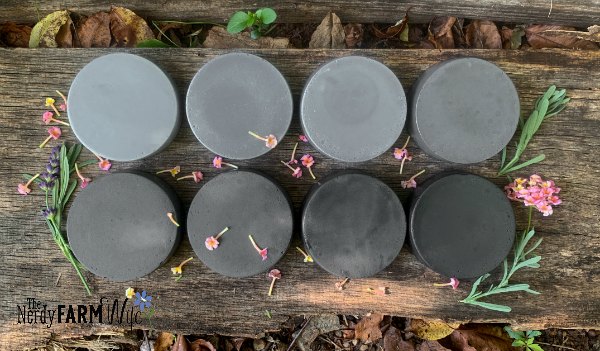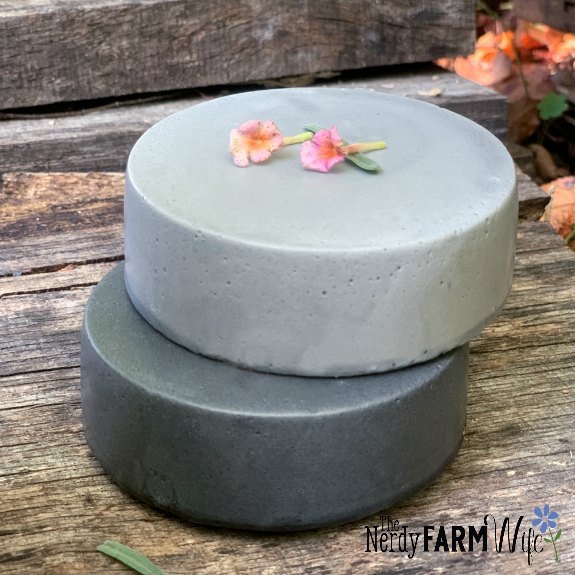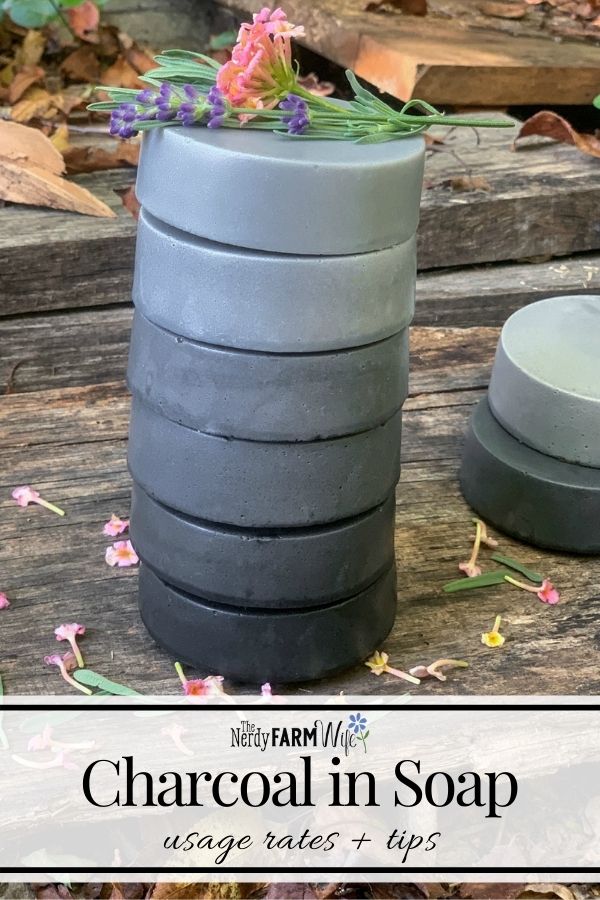Charcoal in Soap: Usage Rates & Tips
Learn how to use charcoal in soap, how much charcoal you need to make gray and black soaps, plus a helpful usage rate table for reference!

Activated charcoal is a popular natural ingredient to include in soap and other skin care products, because of its power to draw impurities from your skin.
(This same action that makes charcoal good for your skin, makes it a useful addition to Black Drawing Salve – which is helpful for splinters, boils, and insect bites.)
What exactly is activated charcoal?
Activated charcoal is a very fine dark black powder that’s produced by processing carbon-rich items such as bamboo, coal, or coconut shells at high temperatures.
That high heat treatment changes its structure and creates an expansive sponge-like surface area, which is what makes it have such tremendous absorbing capabilities.
It can be used internally to absorb toxins and flush them from your body, and is even used for some types of poisoning or drug overdoses.
Activated charcoal is also used externally in skin care products. It’s especially nice for oily or acne-prone skin, though all skin types can use it.
(Important note: Activated charcoal is not the same kind of charcoal that you use for grilling and backyard barbecues, so don’t crush up a briquette and add to your soap.) ?

How much charcoal do you put in cold process soap?
Besides its potential skin benefits, activated charcoal also looks nice in soap, turning it anywhere from gray to black, depending on how much you use.
Over the years, I’ve gotten several requests about how much charcoal to use in cold process soap, so decided to mix up some sample batches and create this handy table to use as a guideline.
Keep in mind that the recipe you use, plus the brand of charcoal, may produce slightly different shades for you.
These samples were made with: 56% olive oil, 25% coconut oil, 13% shea butter, 6% castor oil, with a 5% superfat, and a 2 to 1 water: lye ratio. Brand of charcoal used: Bramble Berry.
Whether your soaps go through gel phase or not can also affect the color. Gel phase usually enhances and darkens natural colorants. (These sample soaps shown did not go through gel phase.)
Use this information as a starting guideline, knowing that you may need to tweak amounts depending on your recipe.
Amount of charcoal to use per pound of oils (PPO):
| 1/8 tsp PPO | light gray soap | white lather |
| 1/4 tsp PPO | medium gray soap | white lather |
| 1/2 tsp PPO | medium gray soap | white lather |
| 1 tsp PPO | dark gray soap | faint gray lather |
| 1 1/3 tsp PPO | dark gray soap | light gray lather |
| 2 tsp PPO | gray-black soap | light gray lather |
| 1 TBSP PPO | black soap | noticeably gray lather |
| 4 tsp PPO | black soap | darker gray lather |
What does PPO mean?
PPO stands for Per Pound of Oils in a recipe.
There are 16 ounces (weight, not volume) or 454 grams in a pound of oil.
So if you want to use charcoal at 1/2 tsp PPO, that means that you would add 1/2 teaspoon of charcoal for every 16 ounces or 454 grams in the recipe.
If the recipe has 16 ounces of oil in it, you would use 1/2 teaspoon of charcoal.
If the recipe has 32 ounces of oil, you would use 1 teaspoon of charcoal.
Most of my recipes have 28 ounces of oil (1 3/4 pound), so you could either round up and calculate as though it has 2 pounds of oil (and get a slightly darker soap), or you could do some math and divide down how many teaspoons for every 4 ounces of oil.
1/2 teaspoon per pound (16 ounces) of oil can be broken down into:
1/4 teaspoon per 8 ounces of oil
1/8 teaspoon per 4 ounces of oil
Using that information, you would see that the recipe with 28 ounces of oil would need 7/8 teaspoon of charcoal to equal the same rate as 1/2 tsp PPO.

When do I add charcoal to soap?
If you’re making a solid colored soap, just add the charcoal to your warmed oils and blend with your stick blender (immersion blender), right before adding the cooled lye solution.
Some soapers like to instead add charcoal to the soap batter at emulsification or when it reaches a very light trace, then use a stick blender to blend it in thoroughly.
If you’re making a charcoal swirl within a different colored soap, you can mix the charcoal with a small amount of oil from the recipe and then blend into a portion of soap batter.
Or, what I normally do instead is mix the charcoal with a small amount of glycerin until it forms a smooth paste, then mix into the portion of soap batter that will be swirled in.
Does it matter if the soap’s lather is gray?
Most people don’t mind that the lather of charcoal soap is often gray, especially if you explain to them up front, that it’s the nature of the soap.
If gray lather bothers you, then just use less activated charcoal for a lighter colored soap and lather.
Black charcoal soap can leave dark marks on your soap dish and washcloths. These will wash out and shouldn’t stain, but you can always reduce the amount of charcoal in the recipe to reduce the chance of this happening.
Does charcoal make your soap softer?
Some soapmakers feel that charcoal makes their soap softer and that it takes longer to firm up in the mold.
If this happens to you, try reducing the amount of water used in your recipe.
If you normally use a full amount of water, try using a 2:1 water to lye ratio instead.
This means that you would use twice as much water as lye. (If your recipe calls for 4 ounces of lye, then use 8 ounces of water.)
You can also add sodium lactate to the cooled lye solution at a rate of 1 teaspoon PPO (per pound of oil in the recipe) to harden soap.
Charcoal Cleanup Tips
Working with charcoal is messy!
The fine powder seems to get everywhere and easily smears across dry surfaces and your hands.
Try these tips for an easier cleanup time:
- Place a sheet of wax paper or a paper towel under the area that you’re working at to catch any charcoal sprinkles and spills.
- After using the measuring spoon, first wipe the charcoal off of it with a dry paper towel, and then wash it with soap and warm water. This keeps the charcoal from sticking to the spoon.
- Use dish soap and warm water to soak and then thoroughly wash all charcoal containing dishes and utensils.
- Charcoal can usually be washed off your hands with soap and water, but if some sticks around, try rubbing coconut oil or a rich hand cream into your skin, then washing again with soap and water.



Beautiful post (as always). Planning to make a soap colored with only activated charcoal in different proportions. Thanks Jan!!!
Thank you so much Seetha! That sounds like an amazing soap! :)
Hi. I love charcoal soap in my facial bars but here is one problem: I tryed any possible way to add it to my badder but although i always burp my stickblender and never mix too much, i always get many superfine airbubbles. Also when i mix it into my batchoils i can see it bubbling up and it seems like it would never end up doing this. I also experimented with soaping temperatures…nothing helps. What can it be?
I never ever had airbubbles in any other of my soaps.
Hi Barbara, I’m so sorry to hear that it’s doing that!
Have you tried mixing the charcoal with glycerin or oil first, in a small container, until it’s very smooth and lump free?
Once it’s nice and smooth, then you can try mixing it into your soap batter and it should mix in quickly.
If that doesn’t work, I wonder if it’s the type (brand) of charcoal?
When you say that you can see it bubbling up, does it make actual bubbles (like fizzing, or like a soft drink bubbles) when you mix it into the oils?
If so, then I would try a different type of charcoal from a different supplier, and make sure it’s pure charcoal with nothing else added.
I hope you find the solution! Keep us updated!
Thank you for your answer. Yes it’s a little bit like in a softdrink but not as strong… I think i’m going to use an other brand. Best wishes from Austria ??
Can you use charcoal in the melt and pour method?
Hi Jeannine, Yes, you sure can! To add charcoal to melt and pour soap, dilute it with about 3 times as much isopropyl (rubbing) alcohol, then stir into melted soap base. So for 1/2 teaspoon charcoal, you would mix it with 1 1/2 teaspoon alcohol. To keep the charcoal suspended in the soap, let the melted soap/charcoal mixture cool to under 135 degrees F (57C) before pouring. I plan to do a post just like this, only for different rates of charcoal + melt and pour in the future on my other website – where you can also see how I use charcoal to make pencil lines in melt and pour soap: https://easymeltandpour.com/tutorials/how-to-make-pencil-lines-in-melt-pour-soap/
I made activated charcoal soap with melt and pour soap, but I find it sweats alot.
Can you please let me know how I can correct it. I’ve wrapped it with cling wrap
Hi Gita! If you live in a climate with higher humidity, you might find a low-sweat soap base helpful:
https://www.theflamingcandle.com/soap-making-supplies/soap-bases/sfic-low-sweat-white-melt-and-pour-soap-base/
You could also try using a dehumidifier in the room you’re storing the soap in.
When soap gets overheated when melting, that can sometimes play a part, so melt slowly & don’t let the base boil.
As soon as the soap is cool and unmolded, wrap it tightly right away and also store in a plastic shoe box.
I hope that helps & happy soap making! ?
Hello,
Can you mix activated charcoal with a super fat and add it at the end of hot process soap when you add the essential oils?
Thanks! Great article!
Hi Alli! You might be able to, but I suspect it will mix into the soap more smoothly if added earlier. I might be wrong though! My area of expertise is in cold process soap making, so I’m much less familiar with hot process techniques. ?
Hi Jan and Alli,
You are correct. Adding the charcoal during the tracing part of the process is the best way to go for a plain bar of charcoal soap using HP.
If you want to do a swirl then mixing the charcoal with the oils used for fragrancing allows a better mixing and more even effect once glopped into the mould.
Hope this helps
Susi Messenger
SoYummy Soap
Adelaide South Australia
Hi Susi, Thank you for sharing those hot process soap tips when working with charcoal! That’s so helpful and much appreciated! ❤
Hello Jan
I have an excess amount of charcoal waste from firing my wood kiln for brick making. The kiln fire at over 1000 deg celcius.
I have been looking for how to turn this waste into good use until I came across your charcoal soap etc. However from your write up you said burnt wood is not classified as activated charcoal.
Any help on how to proceed with what I have so i can make charcoal soaps or other items.
Hi Vincent!
The charcoal used in soap is usually made by burning things like bamboo or coconut shells, so it can definitely be made from wood!
What you don’t want to use is the commercial charcoal briquettes that you buy for grilling, since they have additives besides just charcoal, and you don’t want some of those kinds of things on your skin.
Your charcoal is just one step from becoming activated charcoal – there’s a good summary from https://www.fao.org/3/x5328e/x5328e0b.htm
Scroll down to this part:
“10.1.7. Adsorption capacity
Wood charcoal is an important raw material for activated charcoal. This product is beyond the scope of this manual but some data could be useful where charcoal producers are selling charcoal to be turned into activated charcoal by specialist factories. As produced, normal wood charcoal is not a very active adsorption material for either liquids or vapours because its fine structure is blocked by tarry residues. To convert the charcoal to “activated” this structure must be opened up by removing the tarry residues…”
But, this site seems to support the idea that non-activated charcoal has its uses. (If it can be used internally, I always think it’s fair game to safely test out on your skin too.)
https://www.thelittlefeedcompany.co.uk/blog-post/what-the-difference-between-activated-and-non-activated-charcoal/
Unless you can think of any reason that the charcoal would be exposed to toxins during the burning process, I might would try a little test batch of soap or drawing salve with it, then test it out personally for a while and see what you think of it.
There may be some data I’m missing, since I’m not familiar with the process, but going by my current knowledge base, that would be my best guess!
Just wanted to say a big thank you for doing this. I’m planning a charcoal soap but hate test batching since it eats up both time and raw ingredients.
Hi Christian, I’m so glad the article is helpful!
I read somewhere that activated charcoal was banned in California, because it was found to be a carcinogen. Is that true, or is it a certain kind or brand?
Hi Alita! It seems like California labels everything as cancer-causing (even coffee). :) Here’s a good article that talks about that:
https://www.allergyresearchgroup.com/blog/what-is-proposition-65/
This section in particular:
“Additionally, in some ingredients found in nutritional supplements such as activated charcoal, shown in the photo below, the potentially harmful substances such as lead are very tightly bound. Activated charcoal is a very effective binder of lead and other substances – so much so that it is used for treatment of water and other substances that may contain this contaminant. When taken orally as a supplement, activated charcoal does not release these toxins into the human body, but rather it continues to bind other toxic substances as it moves through the digestive tract, helping to eliminate them from the body.”
Hello! Thank you so much for this article! Very useful. I want to ask if adding too much charcoal (for example 1tsp per 130ml) would be harmful for the skin in any way? I ask because I can see to achieve dark black color of the soap I would like to. I can only do so if I add much higher amount than what is recommended. Thank you for your tips.
Hi Julie! From what I know, it wouldn’t be harmful, the main thing that would happen with a heavy amount of charcoal is that it has the potential to stain washcloths & leave black marks on soap dishes.
If you’re upfront about that happening to the people you give your soap to and they are prepared for that effect, then it should be fine.
I have a charcoal drawing salve recipe that includes a heavy amount of charcoal and stains our skin when we use it, but it’s wonderfully effective, so the premise should be similar for soap too! ?
What is the Ounces of the soap recipe used for these. I don’t understand the %. If I wanted dark gray to black, I would use 2 tsp, correct? Thanks for your help.
Hi Linda! You go by the amount of oils in your recipe.
So if your soap recipe has 16 ounces of oil in it, then 2 tsp of charcoal will give you a dark gray-black (grayish black) soap.
If your recipe has 32 ounces of oil, then you’ll need 4 tsp of charcoal to get a dark gray-black color.
Most of my recipes are 28 ounces, so in that case I would need 3 1/2 tsp charcoal to get gray-black.
The recipe I gave is an example that I used for the batches shown, but you could use your own favorite recipe.
If you have a particular mold size you want to fill and want to use my example recipe, let me know the dimensions, or a link to your mold, and I can help you figure out the amount of oils you would need for your mold. :)
Thanks for this informative piece, it’s a plus that one gets to download a pdf version of it. Very thoughtful ?✨
Hi Starlight, So happy that you enjoyed the article!
I like Print Friendly’s pdf feature too, so I’m glad to hear that it’s useful for others as well! :)